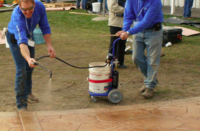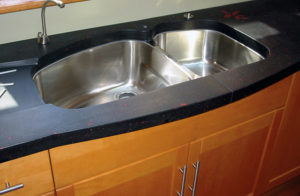Countertop artisans have many considerations to weigh while setting up their fabrication shops – location, size, work flow and equipment, to name a few. And they all have the same goals in mind: to create quality products and run a successful business. Experts from across the country have plenty of advice on how to achieve these goals.
The first task on an artisan’s new-shop to-do list is to choose a location. Some veteran artisans say a nondescript facility that’s not in the center of town is the way to go, since the rent will be cheap and attracting drive-by business is usually not a concern for decorative concrete fabricators. Jeremy French, who owns Mandala Design, in Asheville, N.C., operates his shop in an industrial section of the city that’s close to many useful resources. “We have woodworkers and a lumber yard on each side of us,” French says. “We’re centrally located in terms of our market – we’re close to Lowe’s, a hose shop and a boat shop. We don’t have to travel more than five minutes for 90 percent of our materials.”
The ideal location may depend on the relationship an artisan has with his or her customers, however. Chris Klipfel of CK Concrete Design, in St. Louis, Mo., chose an attractive space downtown because it’s often used to entertain potential clients. “You have to consider the quality of your work space and how easy it is for people to get there,” Klipfel says. “We feel that we should provide an experience, and people think it’s fun to come into our shop.” Tommy Cook, co-owner of construction consulting and training company CM Services – and former co-owner of Absolute Concrete Works in Poulsbo, Wash. – warns that artisans should investigate county codes before settling on a spot. About five years ago, he was briefly put out of business for operating a commercial-industrial business in an area zoned for commercial retail use.
The second move to make while setting up shop is to design an effective interior layout. Bayard Fox, owner of Cement Elegance in Bend, Ore., says the most successful shops are divided into five separate sections: a wood shop for making forms and molds, a manufacturing space, a detailing space, a finishing space for steps such as sealing and spraying, and finally, an area for staging, wrapping and shipping. Fox says ideally, walls should separate each area to keep dust and mixing powders from floating throughout the shop. A showroom should be separated from all work areas, he says.
“The biggest challenge is dust,” Fox says. “It’s important to make sure your showroom is separate, and it’s good to have a dust containment system because dust can migrate into the showroom. And your wood shop needs to be separate – wood dust is not good to have near concrete.”
While a showroom is valuable for allowing clients to view samples of an artisan’s work, some experts feel potential buyers can benefit from seeing the work space as well. Todd Sarandos, of Red Concrete, in Burlington, Vt., says he’s planning to shrink his current showroom and use a portion of it as a finishing space where customers can see what’s being worked on. “Clients also like to see what’s in progress,” he says.
Experts agree that the organization of an artisan’s workplace should be determined by work flow as well as the size and type of projects on the artisan’s agenda. Each new project enters a shop as a set of raw materials, travels through a number of stages and finally exits as a finished piece, so artisans should organize their work areas according to the path they want their pieces to take. Sarandos says his projects travel in a loop from station to station, while French says his shop is set up so raw materials can enter the front and completed projects can exit the back.
Jeff Kudrick, co-owner of J&M Lifestyles LLC in Randolph, N.J., stresses it’s important for artisans to establish a project protocol that they can stick to, which will help them use their time efficiently and make fewer mistakes. This includes not only the physical setup of the shop, but also the use of paperwork to keep track of each step. “Come up with a full process that works,” Kudrick says. “In the shop, plan your route from the time a piece is made to the time it goes out. It’s a matter of recording all of your information and following a process.”
Large projects require more space, or at the very least, the flexibility to create more space. Sarandos has a lot of open space to work with in his large warehouse shop that’s divided up by shelving, and the space was recently put to good use when he created 14 large picnic tables for a university. Klipfel recently fabricated 24-foot-long steel casting tables for a large project – casting display bases for mannequins in Macy’s department stores across the country. The tables were then broken down to smaller sizes for everyday use. He also makes the most of his space by bolting different-sized tables together when needed, instead of taking up additional space in his shop by bringing in a new, larger table.
And most artisans agree mobility is important, which is why tables with wheels are often favored. “You can never have too much space,” Klipfel says.
Equipment and tool choices can be simple or elaborate, and experts say they’re likely to be determined by the artisan’s budget and the type of work he or she plans to do. Cook says that at minimum, an artisan opening his or her first shop needs a chop saw, table saw, air compressor, nail gun and drill for the woodworking area, plus a vibrator, concrete mixer and concrete trowels for the casting area. If the artisan advances to working with glass-fiber reinforced concrete (GFRC), Cook recommends a high-shear mixer, a peristaltic pump and a calibrated scale.
Folks just starting out can save money by purchasing used equipment and tools on Craigslist or at pawnshops, swap meets and flea markets, Cook suggests. Sarandos says he purchased a used forklift and scored some industrial racks for free from a nearby business that was closing. But, all experts warn that old equipment is used at the artisan’s risk. “If you make a bad decision, something could break down,” French says.
Tables to work on are essential to any shop, and Sarandos says to make sure their surfaces are consistently flat. He says if concrete isn’t casted on a flat, level surface, the results will be irregular. So if after multiple uses a table’s surface becomes flawed, it needs to be replaced, as he recounts from personal experience. “We were banging our heads against the wall for a while trying to figure out why the concrete was coming out with a curl or twist to it,” he says.
Every concrete countertop manufacturer knows how much productivity affects the bottom line of their business. To increase productivity, experts recommend that all artisans set up shops for maximum efficiency – for example, if tools are stored near work stations and replaced after each use, workers will save time searching for items and complete more work in the long run. “Our guys were spending most of their time looking for stuff, so we stocked both of our woodworking areas with the same tools so they wouldn’t have to walk halfway across the shop,” Klipfel says.
Cook stresses having “a place for everything and everything in its place,” or practicing what he calls ergonomics. “You want to be able to access areas with an even flow and not have to walk across the room to get something,” he says.
Sarandos suggests outsourcing some work if possible, which will also save workers’ time. “Instead of being crowded and cramped in our space, we work with other woodworkers and carpenters who get a portion of our work,” he says. And last not but not least, keep the shop clean. “I’ve had people come in and say, “Wow, this place is clean for a concrete shop,'” Cook says. “If you don’t keep it clean, it’s going to be harder to clean it up later. When concrete sets, it’s not easy to scrape it off the floor.”

















